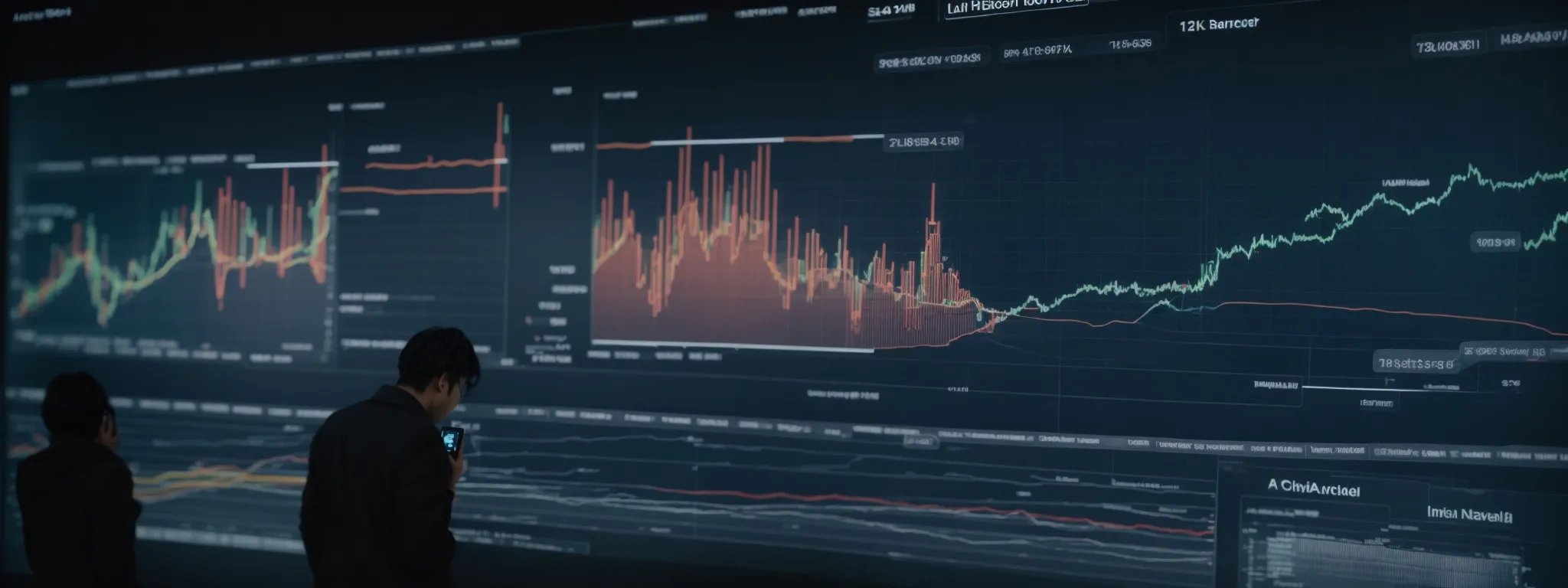Link Reclamation Using Google Webmaster Tools
Mastering Link Reclamation With Google Webmaster Tools In the realm of digital marketing, link reclamation is an essential strategy for maintaining a website’s strength in search engine […]
Mastering Link Reclamation With Google Webmaster Tools
In the realm of digital marketing, link reclamation is an essential strategy for maintaining a website’s strength in search engine rankings.
Utilizing the tools provided by Google Webmaster offers website owners a powerful resource to identify and restore lost backlinks, thereby safeguarding their online presence.
Through vigilant tracking and methodical steps for recovery, one can ensure that every valuable link contributes to their site’s credibility and visibility.
Keep reading to uncover expert techniques for leveraging Webmaster Tools and turn link reclamation into a potent aspect of your SEO toolkit.
Key Takeaways
- Link Reclamation Is Vital for Maintaining SEO and Requires a Systematic Monitoring Approach
- The Use of Google Webmaster Tools Is Essential for Identifying and Recovering Lost Links
- Effective Communication With Webmasters Is Central to the Process of Link Reclamation
- Regular Analysis of Backlink Data Optimizes Future Link Building Strategies
- The Constant Evolution of SEO Necessitates Ongoing Refinement of Link Reclamation Techniques
Understanding Link Reclamation in Webmaster Tools

In the arena of search engine optimization, link reclamation stands as an underutilized yet highly effective strategy for bolstering a site’s link profile.
Employing Google Webmaster Tools, professionals glean insights into lost or broken backlinks, setting the stage for reclaiming them and thus, reinstating the associated SEO value.
Understanding the process of link reclamation and Incorporating Google Webmaster Tools is not merely a best practice for SEO experts; it is an essential tactic in the ever-evolving quest for digital prominence.
Mastery of these tools empowers webmasters to identify discrepancies in their link inventory and proactively address them, ensuring the integrity of their website’s network and its potency in search rankings.
What Link Reclamation Involves
Link reclamation involves the meticulous process of Tracking Down Backlinks that once pointed to a website but have become disconnected or broken over time. Restoring these links is vital for maintaining a website’s authority and ensuring the seamless flow of traffic, which ultimately impacts search engine rankings.
It requires a sharp eye and a Strategic Approach, where professionals analyze reports from Google Webmaster Tools to identify the root cause behind the loss of a backlink. Addressing these causes could range from rectifying a simple URL redirection to mending relationships with webmasters for reinstated linkage.
Why Google Webmaster Tools Is Essential for Reclamation
Integrating Google Webmaster Tools into the framework of link reclamation is non-negotiable due to its comprehensive diagnostics. It unveils the landscape of a site’s backlink profile, pinpointing where links have failed and providing the data necessary for effective recovery strategies.
The utility of Webmaster Tools extends beyond simple identification; it Equips Professionals with the agility to swiftly restore lost links. This rapid response capability facilitates the preservation of a domain’s authority, crucial for maintaining search engine visibility and credibility.
| Link Reclamation Step | Tool Utility | Impact on SEO |
|---|---|---|
| Identify Lost/Disconnected Links | Data Retrieval & Analysis | Consolidates Backlink Integrity |
| Analyze Link Loss Causes | Diagnostics & Reporting | Informs Reclamation Approach |
| Execute Reclamation Tactics | Agile Link Recovery Features | Boosts Domain Authority & Rankings |
Setting Up Google Webmaster Tools for Link Tracking

Before diving into the intricacies of link reclamation, one must first establish a foundation for monitoring and managing backlinks effectively.
Setting up Google Webmaster Tools, now known as Google Search Console, is a preeminent step that enables webmasters to maintain a vigilant watch over their site’s backlink profile.
The initial phase entails verifying site ownership, a gatekeeper step to ensure that only authorized users have access to sensitive data.
Upon successful verification, navigating to the Links section unveils a comprehensive view of the external and internal linking landscape.
Webmasters become adept at utilizing the dashboard interface, which serves as a command center from where they can launch their reclamation expeditions with precision and confidence.
Verifying Your Site Ownership
Initiating the use of Google Webmaster Tools for link reclamation necessitates establishing site ownership. This authentication step, pivotal to the procedure, ensures access to the tool’s in-depth analytics is kept secure and in the hands of the rightful website manager.
Upon commencing the Ownership Verification, webmasters have several methods at their disposal: uploading an HTML file, adding a meta tag, making a DNS record, or using a Google Analytics code. Selecting the right method hinges on the user’s technical proficiency and access levels to the website’s server or hosting provider.
| Verification Method | Required Access | Suitability |
|---|---|---|
| HTML File Upload | Server Access | Ideal for those with direct file system control |
| Meta Tag Addition | Site Editor or CMS | Convenient for users with web editor privileges |
| DNS Record | Domain Registrar | Recommended for those who manage domain settings |
| Google Analytics Code | Google Analytics | Suitable for businesses already using Google Analytics |
Navigating to the Links Section
Once webmasters have securely verified their site’s ownership in Google Webmaster Tools, the next critical step is navigating to the Links section. Here, they gain access to a bird’s-eye view of the site’s backlink profile, monitoring not just the quantity, but the quality of external links that influence search engine rankings.
The Links section provides a detailed report, showcasing both internal and external links, Top Linking Texts, and the pages receiving the most links. This strategic overview is the foundational layer that equips SEO professionals with the necessary information to commence the meticulous process of link reclamation.
Familiarizing With the Dashboard Interface
Once inside the Google Webmaster Tools dashboard, users should take time to become familiar with its layout and functionalities. The dashboard’s user-friendly interface is designed to provide quick navigation to crucial metrics and tools, helping to streamline the link reclamation process.
Each section on the dashboard is clearly labeled, allowing for straightforward access to different data sets such as crawl errors, search analytics, and the all-important links to your site information. Understanding how to interpret and utilize this data is key to identifying Link Reclamation Opportunities:
| Dashboard Section | Function | Relevance to Link Reclamation |
|---|---|---|
| Crawl Errors | Monitors issues preventing indexing | Identifies broken URLs to reclaim |
| Search Analytics | Tracks visibility and search performance | Screenshots traffic loss due to link issues |
| Links to Your Site | Lists backlinks and anchor text | Pinpoints lost or disconnected backlinks |
The carefully designed structure of Google Webmaster Tools equips SEO professionals with the means to quickly assess and act upon the information presented, ensuring that their link reclamation efforts are both efficient and effective.
Identifying Lost Links With Google Webmaster Tools

In the nuanced world of SEO, one of the imperative tasks confronting webmasters is the identification of lost links, a process that serves as the cornerstone of link reclamation strategies.
Google Webmaster Tools offers indispensable resources for this purpose, with the ‘Top Linking Sites’ report and the ‘Top Linking Pages’ feature providing a robust foundation for a comprehensive analysis.
These tools equip SEO professionals to detect patterns in the erosion of their backlink profiles, enabling them to spot trends in lost backlinks with precision.
Ultimately, this proactive identification facilitates the restoration of valuable links, reinstating the SEO strength they originally contributed to the website.
Utilizing the ‘Top Linking Sites’ Report
When it comes to revitalizing one’s SEO stance, deploying the ‘Top Linking Sites’ report within Google Webmaster Tools is a tactic of strategic importance. This component of the tool distills the essence of a website’s external endorsement, highlighting the domains with the most influential link juice directed towards the site in question.
SEO professionals leverage this report to scout for lost connectivity, as it reveals which previously engaged sites have ceased linking back. Prompt identification through this insightful feature enables swift remedial action, a critical step to avoid the detrimental impact of eroding backlink profiles on search rankings.
Analyzing the ‘Top Linking Pages’ Feature
The ‘Top Linking Pages’ feature within Google Webmaster Tools comes forth as an indispensable asset for SEO experts focusing on link reclamation. It provides A Detailed Examination of specific web pages that harbor the most significant number of backlinks, offering a granular view of where a site’s link equity is concentrated.
In executing a thorough link reclamation strategy, using the ‘Top Linking Pages’ illuminates pathways to understanding which high-value pages may have lost links. SEO professionals are thereby equipped with precise data, enabling them to strategically target and rectify issues at the page level, preserving and enhancing the site’s overall link profile.
Spotting Trends in Lost Backlinks
Expert practitioners recognize the power of pattern analysis in the realm of link reclamation, utilizing Google Webmaster Tools to uncover trends in lost backlinks. By pinpointing recurrence in link loss, they can strategize effectively to prevent future disconnects and fortify their backlink profile against similar vulnerabilities.
The ability to spot and understand commonalities in lost backlinks translates to more than mere reclamation; it offers insights into the broader health of an SEO strategy. Investment in this depth of analysis not only recovers lost links but also guides the refinement of ongoing link building practices to stabilize the website’s search engine standings.
Steps to Reclaim Lost Links Effectively

Embracing link reclamation within Google Webmaster Tools can transform a website’s search engine optimization strategy from competent to cutting-edge.
By meticulously reviewing 404 error pages, engaging with webmasters, and skillfully implementing 301 redirects, professionals can accelerate the recovery of lost links.
Each of these steps is a delicate operation requiring precision and tactful communication to ensure that valuable backlinks, which form the bedrock of a website’s SEO strength, are effectively reclaimed.
The ensuing discussion sheds light on how to navigate these critical facets of link reclamation, capitalizing on Google Webmaster Tools’ robust capabilities to enhance a site’s presence in search engine results.
Reviewing 404 Error Pages
Reviewing 404 error pages emerges as a critical step in link reclamation, demanding a precise and systematic approach. This process involves the analysis of elements causing lost links, which are often the result of pages that no longer exist on a site, leading to the dreaded ‘Page Not Found’ response.
Proactively addressing these 404 errors is pivotal, as they represent both a loss of potential traffic and a diminishing factor in the site’s SEO profile. Consequently, professionals keen on SEO best practices prioritize the identification and correction of these errors:
- Scour Google Webmaster Tools for crawl error reports to pinpoint 404s,
- Map the broken URLs to their most relevant, existing pages,
- Implement 301 redirects to salvage the link value and user experience.
The act of reclaiming links from 404 error pages not only recovers lost SEO capital but also enhances the site’s user experience. It reflects a brand’s dedication to maintaining a seamless, professionally curated web presence, showcasing attention to detail and commitment to the audience.
Reaching Out to Webmasters for Reclamation
The endeavor of reaching out to webmasters is an integral part of the link reclamation process. This task requires tact and a strategic approach to communication, as the goal is to re-establish a previously beneficial link without overstepping professional boundaries.
Having the right approach can facilitate a positive response: it entails drafting a courteous and informative message that explains the broken link issue and offers a simple solution. Timing and the choice of communication channels are essential, as they can significantly influence the outcome of the reclamation efforts:
- Identify the correct contact information for the webmaster or site owner.
- Craft a clear and concise outreach email, providing all necessary details and requesting the restoration of the link.
- Follow up if needed, but always maintain a professional tone and respect the webmaster’s decision and response time.
Implementing 301 Redirects for Link Recovery
In the process of reclaiming lost links, implementing 301 redirects stands out as a vital recovery tactic executed through Google Webmaster Tools. This method effectively re-routes the traffic from a defunct URL to a relevant, active page, thereby preserving the link’s value and improving the user experience.
SEO specialists utilize 301 redirects to signal search engines that a page has permanently moved, which helps in maintaining the integrity of the site’s link profile. It is a Strategic Maneuver that ensures the continuity of the link equity accumulated over time, pivotal for sustaining the website’s search engine rankings.
Monitoring Reclaimed Links for Long-Term Success

Securing the recovery of lost links is a pivotal aspect of maintaining SEO momentum, yet the endeavor does not end with the mere reclamation of these digital assets.
Vigilant monitoring ensures that the efforts invested do not unravel over time.
Setting up alerts for lost links is a proactive measure to detect issues.
Keeping track of the progress made in reclaiming lost links serves as an effective gauge of the health of a website’s backlink profile.
Additionally, repeatedly analyzing the data gathered through Webmaster Tools allows for the honing of reclamation tactics and the adaptation of strategies to evolving online landscapes.
This multifaceted approach fortifies a site’s authority and ensures its enduring success in search engine rankings.
Setting Up Alerts for Lost Links
In the pursuit of SEO supremacy, implementing a system for immediate notification of backlink losses through Google Webmaster Tools is integral. Setting up alerts enables SEO professionals to immediately identify when a link no longer points to their site, allowing them to act swiftly to begin the reclamation process.
Proactive monitoring with alerts serves as an early warning system, guarding against the erosion of a website’s backlink profile. As soon as a lost link is detected, the responsible SEO team can investigate the cause and assess the potential impact on the site’s search engine performance, thus maintaining its competitive edge.
Keeping Track of Reclaiming Progress
Maintaining a systematic approach to tracking the progress of link reclamation is essential for SEO professionals. As such, it is crucial to scrutinize the performance of restored links actively, evaluating the influence they hold over the ongoing search engine ranking position and the overall health of the website’s backlink profile.
Achieving success in link reclamation heavily relies on the continuous observation and management of the reinstated links. Webmasters must ensure the durability and stability of these connections within Google Webmaster Tools, thus safeguarding the site’s revitalized link equity and contributing to sustained SEO performance.
Adapting Strategies Based on Link Data Insights
Insights gleaned from link data provide SEO specialists with the opportunity to refine their strategies, ensuring that their approaches align with the ever-changing algorithms of search engines. By analyzing patterns and outcomes from reclaimed links, experts can adapt and evolve their methodologies, staying one step ahead in the competitive realm of search engine optimization.
Critical assessment of link reclamation outcomes through Google Webmaster Tools enables practitioners to determine the efficacy of their efforts. This evaluation offers a clear perspective on which tactics yield the most robust link profile, empowering professionals to make data-driven decisions to enhance their SEO campaigns continuously.
Leveraging Data From Reclaimed Links for Future Growth

The dynamic domain of search engine optimization rewards those who not only reclaim lost links but also expertly utilize the data from these renewed connections to fuel future growth.
This strategic approach harnesses the potential of Google Webmaster Tools to scrutinize the influence reclaimed links have on a website’s performance.
By critically assessing their impact, SEO professionals can sculpt more informed link building strategies, ensuring sustainable enhancement of their digital footprint.
Additionally, the evolving nature of search engines calls for a continual refinement of link reclamation techniques, fostering a cycle of improvement that keeps websites robust in an ever-competitive online space.
Analyzing the Impact of Reclaimed Links
Analyzing the impact of reclaimed links is a critical part of the SEO cycle that allows professionals to measure the effectiveness of their reclamation strategies. By examining metrics such as referral traffic, link quality, and ranking improvements, they can distill valuable insights to optimize future endeavors.
Insightful data analysis following link reclamation offers a glimpse into the also true effectiveness and value each restored link brings to the table. From this vantage point, SEO specialists can validate their efforts and adjust their approaches to maximize their resources judiciously:
- Evaluating the changes in search engine rankings as a direct consequence of link restoration.
- Assessing how reclaimed links affect website traffic, user engagement, and conversion rates.
- Identifying any correlation between the restored links and the overall domain authority enhancement.
Informing Future Link Building Strategies
Through vigilant analysis of recovered links, SEO specialists are poised to sculpt forward-thinking link building strategies. The intelligence acquired from reclamation outcomes informs decisions on future link acquisition targets, enabling a more effective and sustainable approach to growth within the digital marketplace.
With the concrete data in hand, practitioners adjust their link building initiatives to circumvent previously encountered pitfalls, thus ensuring a robust backlink profile that is resistant to future losses. This preemptive planning, guided by past reclamation experiences, solidifies a website’s standing in the search engine results, providing a strategic advantage in the competitive online environment.
Continually Refining Link Reclamation Techniques
Industrious SEO professionals understand the importance of refining link reclamation techniques as a perpetual component of their digital toolkit. With each iterative cycle, they employ data-driven refinements, honing their skills to better identify lost backlinks, enhance communication strategies, and streamline the recovery process through tools like Google Webmaster Tools.
As SEO landscapes shift and technology evolves, the imperative to adapt reclamation methodologies becomes clear. Seasoned webmasters stay abreast of the latest developments, integrating novel techniques and emergent technologies to ensure the efficiency and success of their link reclamation efforts remain at the cutting edge.
Conclusion
Mastering link reclamation using Google Webmaster Tools is a critical strategy for maintaining and enhancing a website’s SEO profile.
This process allows SEO professionals to proactively identify, recover, and preserve valuable backlinks that have been lost or disconnected over time.
By utilizing the comprehensive diagnostics and reporting features of Google Webmaster Tools, experts can swiftly address and reclaim these links, thereby reinforcing the site’s domain authority and search engine rankings.
Additionally, setting up alerts for real-time monitoring of backlinks fortifies the website’s standing against potential link erosion.
Through meticulous tracking and analysis of reclaimed links, webmasters can gain insights to inform and refine future link building strategies, ensuring a robust, enduring online presence.
Continual refinement of link reclamation techniques keeps SEO efforts dynamic and competitive in the evolving digital landscape.



















































































